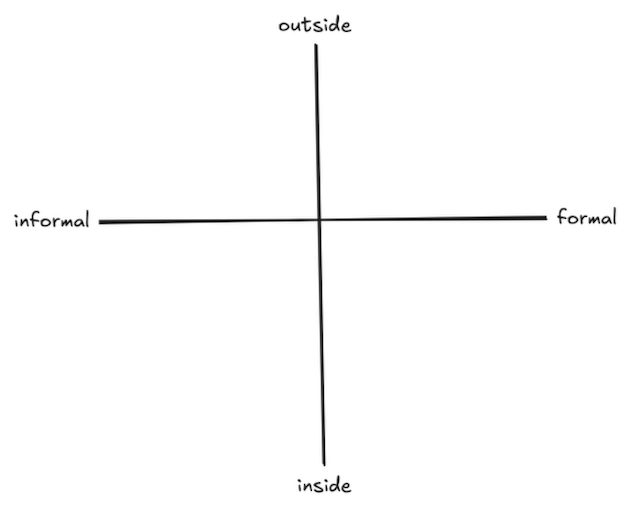Uncovering power structures – An exercise for talking about power

In this article, we share instructions for an exercise we developed to facilitate conversations about power structures in our organisation.
For a democratic, sustainable and resilient future, we demand transparency, participation and cooperation on an equal footing from politicians. In our organisation, we strive to not only represent these values externally, but also to live them internally.
It is important to talk openly and calmly about power structures so that we can fulfil our demands for transparency and justice internally. This is an honourable approach, but one that is often difficult to implement in practice. Even if we have flat, transparent hierarchies, unspoken power relations and routines will form outside the official channels. The less they are addressed, the more entrenched they become. We must review formal structures to ensure that they have sufficient counterbalances and control mechanisms. We must recognise and name informal power so that it is not distributed unfairly.
We have developed a small exercise that reveals power structures within a team. We have repeated this exercise at our annual team retreat. It helps us to create a common understanding of current structures and allows us to address power relations that are otherwise often taboo.
Power is not automatically bad: power means you can make things happen. Every organisation needs centres of power so that decisions can be made. However, these centres of power must be as transparent and open as possible so that no one is excluded.
Guidelines for discussing power structures
The aim of the exercise is to identify the power structures, instruments of power and other factors relating to power within the organisation. The point is to discuss these issues. We do not need to find a solution, and this exercise does not aim to change anything at this point. The value lies in making these issues visible and addressing them.
The exercise takes 60 to 90 minutes, depending on how many people you are and how much time you want to spend on the discussion.
You will need a surface that you can divide into four quadrants (you can do this with pens on a whiteboard, chalk on the floor or tape on a table – anything is possible), cards or large sticky notes, pens and, optionally, adhesive dots, tape, pins or magnets to attach the cards.
Divide the space into four quadrants by drawing two axes. One axis runs from informal (not written down) to formal (officially agreed), the other axis runs from inside (how it works internally) to outside (what can be seen from the outside).

Illustration of the axes outside-inside, informal-formal for the exercise Uncovering power structures
After the introduction, you divide into small groups of up to four people. Write down on the cards any structures, instruments and other factors that come to mind that grant power in your organisation. Record your observations as neutrally as possible.
After about 30 minutes, everyone comes back together and places the cards on the quadrants. It is not always clear where a card belongs. For example, community members in positions of power can be placed either inside or outside, depending on how closely the community is integrated into your organisation. In this case, you can duplicate the card or decide on a field. It does not have to be perfect; some ambiguity is okay.
A few examples: · Internal, informal - Friendships/relationships within the team; project founders (if no formal title is associated with this), a desk close to the boss and therefore a direct line of communication; Interal, formal - Financing structure; unrestricted funds vs. project funds with conditions; internal committees where decisions are made; External, informal - A strong community whose opinion influences decision-makers within the team; a colleague who is well known publicly; External, formal - Traditional roles and governance bodies such as the board, management, general meeting, team leads and project managers;
We have identified power through social privileges such as being white, origin, gender etc. as informal power, on the border between internal and external.

Photo: Team and board members do the exercise on power structures at our retreat.
Once all the cards have been placed, look at the overall picture: Are there quadrants with a particularly large number of cards, while others have very few?
In our experience, we have always collected more on informal power than on formal structures. We have very flat hierarchies on the outside, but are quite complex on the inside, with many stakeholders in large networks.
Informal power is exciting to explore because we talk about it less often, because it is not yet explicit. An exercise like this may be the first time that something is officially stated that would otherwise only be expressed in one-on-one conversations or in the office grapevine. At this point, it is important that everyone involved sticks to value-neutral statements and that the atmosphere remains relatively relaxed. The exercise is therefore not suitable as a measure in an acute conflict situation, but rather serves as a regular preventive care and maintenance of cooperation.
For reflection within the entire team, we mark cards (e.g. with sticky dots) that we want to highlight. Guiding questions for this could be: Did anything surprise me? Does anything make me feel uneasy? What should we keep an eye on? Afterwards, we talk about the observations in a discussion moderated by one or two people (from the team). We record the results by photographing the cards on the quadrants and writing down the observations that came up in the discussion in short sentences.
Even if there is no concrete outcome to the exercise, its value lies in the fact that we are talking about power. When we talk openly about power, we create a climate in which criticism is easier. It pays off to engage in this kind of reflection on a regular basis. Power relations change as the organisation, the team, society, our communities and the funding landscape change. We therefore need to check in regularly and reflect on our own structures, even if there are no particular problems at the moment. This creates a basis for discussion that helps us to respond better in the next conflict situation. Regular reflection on power relations also allows us to compare results over time and perhaps identify successes and improvements that are worth celebrating.
Why all this?
We uncover power structures…
… so that we can live up to our standards of transparency and fairness internally as well as externally.
… to check whether power is actually distributed fairly within our organisation, as we would like it to be in theory.
… to create a climate in which criticism is possible and acceptable.
… because power, when distributed well and used correctly, can achieve a lot of good.